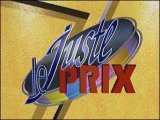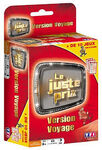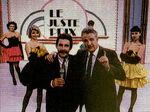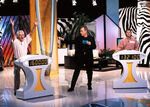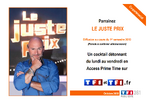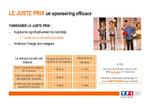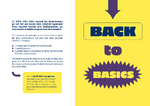| Aired | |
| TF1 (1987-2001, 2009-2015) M6 (2024-present) | |
| Host | |
| Max Meynier (1987–1988) Eric Galliano (1988) Patrick Roy (1988–1992) Philippe Risoli (1992–2001) Vincent Lagaf' (2009–2015) Eric Antoine (2024-pressent) | |
Game Format[]
Like The Price is Right, Le Juste Prix revolves around correctly estimating the price of various consumer goods (grocery items and merchandise), in several games with increasing stakes.
Les Estimations (One Bid)[]
At the start of the show, four audience members are called to come on down by the announcer, before the host enters through a door (either one of the Big Doors, or a specifically built entrance). This staging remained from 1987 to 1998. From 1998 to 2001, then from 2009 to 2012, and from 2024 onwards, the host makes his entrance before the first four contestants were called. From November 2012 to April 2015, the first four contestants were already at Contestants' Row at the start of the show.
From 1987 to 2001, contestants were selected at random in the studio audience. From 2009 onwards, they are actually pre-selected via auditions, with only their calling order being random. The first four contestants always line up from left to right in their calling order.
A prize is presented to the four contestants and described by the announcer. Each of them, from left to right (from the viewer's perspective), gives a single estimate of its price (which must be integer, as it is rounded off to the nearest unit). The first to bid is the leftmost contestant for the first Estimation of the day, and the newest contestant for all the others. The closest to the actual retail price without going over wins the prize and joins the host onstage to play a Pricing Game. If everyone overbids, they must all give a new bid below the previous highest one, until at least one contestant ends up below the actual retail price. An overbid is signalled by a succession of buzzers in the 1987-2001 era, and by the bids turning red in the 2009-2015 era (with the "wrong answer" cue playing).
In 2000-2001, contestants had 10 seconds to think and give their bid.
Until 2001, if a contestant gave the exact price of the prize, a jingle was heard and he/she also won a check of FF1,000. Between 1996 and 1998, one of the Estimation prizes was sponsored, and if a contestant gave the actual retail price of that prize, both they and one of the readers of the sponsor won a car. In the Lagaf' era, there was originally no bonus for giving an exact bid for an Estimation prize. A first bonus was introduced on Friday, December 17, 2010, namely a small symbolic trophy with the show's logo. From September 26th 2011 on, it also came with a €100 bonus, much like in the original version. In the Antoine era, a perfect bid awards €100.
In 2001, when an airport terminal sound was heard during an Estimation, the contestant to win it was to take part in the special Pricing Game called Le Grand Voyage (a variation of Clock Game played for a trip, with a 20-second clock).
At the end of a Pricing Game, the empty spot is filled by a new contestant called from the audience. There are:
- 3 Estimation rounds from 1988 to 2000, and from 2009 to 2015.
- 4 Estimation rounds in 2000-2001 (only 3 on Sundays), and from 2024 onwards.
- 6 Estimation rounds in 1987-1988 and from March to August 2001.
Le Jeu (Pricing Games)[]
The winner of the Estimation takes part in a Pricing Game, designed around guessing the price of grocery items and merchandise. Prizes at stake in a Pricing game can be a set of of small prizes, one big prize, or a sum of money, or a combination thereof. Most games are adaptations of the American Pricing Games, but from 1998 onwards, there are also original French creations among them. Regardless of the outcome of their Pricing Game, the contestant is automatically qualified for the semi-final round, La Roue (Showcase Showdown), at the end of the show.
From 1998 to 2001, as an early introduction to the then-upcoming pan-European currency, some Pricing Games were played with either Francs or Euros, or both.
La Roue (Showcase Showdown)[]
The three/four contestants who made it onstage face a big wheel divided into 20 segments, randomly numbered in increments of 5, from 5 to 100. They spin the wheel, and try to get the highest score possible. In 1987-1988, briefly in 1999, and from 2009 onwards, contestants may spin the big wheel twice if they get an insufficient score on their first one. However, both scores add up, and going over 100 results in an automatic elimination. From 1988 to 2001, and on Friday shows in 2024, contestants may only spin the big wheel once. From 1993 to 2001, the big wheel was reset to 100 between each contestant's turn. From 2024 onwards, it is reset to 100 after every single spin. From 2009 to 2015, it is only reset in case of a tie breaker.
From 1987 to 2001, the playing order was the order in which the contestant played their Pricing Games. From 2009 onwards, contestants spin the wheel in the reverse order in which they played their Pricing Games.
After every contestant has spun the big wheel, the one with the highest score (as close as possible to 100 without going over) wins the round. In case of a tie, tied contestants spin the big wheel again once each, and the highest score wins.
- in 1987-1988, and from March to August 2001, the winner qualified for the Showcase round at the end of the show
- from 1988 to March 2001, the winner came back on the Sunday show, which served as the weekly finals.
- from 2009 to 2015, the winner advanced to the Showcase round, played immediately after
- from 2024 onwards, much like in 1988-2001, the winner qualifies for the Friday show, the weekly finals.
On Sunday shows from 1988 to 2001, and on Friday shows in the Antoine era, the two highest scores win the round and advance to the Showcase.
In 1987-1988, like in The Price is Right, a FF1,000 prize awaited a contestant who scored 100 in either one or two spins. They also got a bonus spin, with FF5,000 at stake for landing on 5 or 15, or FF10,000 for landing on 100.
From 1995 to 1998, there was a prize pool at stake in the Roue round: La Cagnotte (the Jackpot). It started at FF1,000 and increased by ten times the score of each contestant who failed to spin a 100. If a contestant spun a 100, they won the jackpot, which was reset to FF1,000 afterwards. In case of tie breakers, the jackpot was neither winnable, nor increased with new spins.
In 1999, Le Juste Prix temporarily re-adopted the two spins system, and the jackpot was only winnable on a contestant's first spin. Due to the overcomplication of the rules (owing to the double spins and the over-100 scenarios), the Cagnotte was retired and replaced with a prize at stake, presented by the announcer at the start of the round. The prize system survived the eventual restoration of the single spin rule, and stayed until the end of the original run of Le Juste Prix in 2001.
La Vitrine (Showcase)[]
In the final round of the show, the contestants play for an ensemble of prizes of high value, which they must estimate.
In 1987-1988, when the show was only broadcast on Sundays, the format was like that of the hour-long one of The Price is Right, with two sets of three Estimations, three Pricing Games and one Roue round, with one contestant selected in each of the Roue rounds. Likewise, there were two showcases at stake like in The Price is Right. The round played almost exactly like its American counterpart. The first showcase was presented, and the contestant who achieved the highest score at the big wheel could decide either to bid on it or pass it to their opponent, who then had to give a bid. The second showcase was then presented for the contestant who had not bid yet. The contestant that was closest to the actual retail price of their showcase won it. If they were within FF1,000 below the actual retail price of their showcase, they won both showcases. In some episodes, in case of a double overbid, the contestants could be allowed a new bid until there was a winner.
From July 1988 to March 2001, Le Juste Prix aired everyday, and the Showcase was weekly. Shows from Monday to Saturday followed the format of the half-hour era of The Price is Right, although ending with the Roue round (in 2000-2001, there were four Estimations and Pricing Games from Monday to Saturday). No Showcase was played, and the highest score came back on the weekly finals, on the Sunday show. From 1998 to 2001, the winner of La Roue played Le Grand Voyage for a trip. On Sunday, the six winners of the week returned (called to come on down in a random order) and played again with the same format, with three Estimations and three Pricing Games, and a Roue round at the end. This time, two contestants were selected. The Showcase was then presented entirely to them (from Monday to Saturday, one part of the Showcase was presented before the Roue round). The two contestants were given fifteen seconds to estimate it secretly in writing. Their bids were then revealed to the audience and the viewers, followed by the actual retail price of the showcase. The contestant that bid closest to the actual retail price of the showcase without going over won it. In case of a double overbid, there was no winner.
From March to August 2001, Le Juste Prix aired from Monday to Friday, once again with the one-hour format of The Price is Right, and the Showcase became daily. Like in 1987-1988, one finalist is selected on each Roue round. At the beginning of the final round, the highest-scoring contestant at the Roue selected a range, between FF5,000 and FF20,000, via a mini-game played on the studio video wall. The showcase of the day was then presented, and estimated secretly by the two finalists, like before. This time, to win the showcase, the contestants not only had to be the closest to its actual retail price without going over, but also had to be within the range selected at the start of the round.
From 2009 to 2015, the Vitrine round played like Clock Game. The showcase was presented to the contestant, who was given 30 seconds (July 2009-March 2013) or 25 seconds (August 2013-April 2015) to guess its actual retail price to the euro, guided by the host who told them after each guess "higher" or "lower". The showcase value could not exceed €50,000, except between January and May 2010 where it could be worth up to €100,000. From 2009 to 2012, the showcase was also always worth at least €10,000. If the contestant managed to guess the actual retail price of the showcase within the time limit, they won it.
From 2024 onwards, the Showcase is weekly again. The winners of the week come back on the Friday show as the first four contestants. The show plays like the regular shows until the Roue round. "New contestants" called after each game are the three highest-scoring contestants at the Roue round this week (aside from the first four). The Roue round calls for two winners, and plays with the single spin rule. The highest-scoring contestant then determinates a range like in 2001 (from €1,000 to €5,000), and the showcase is recapped to the two finalists (like in the original run, it is partially presented on each weekly shows), who then have 20 seconds to estimate it secretly via a tablet. The contestant closest to the actual retail price of the showcase without going over, and within the selected range, wins the game. If both contestants either overbid or underbid, the showcase is lost.
Merchandise[]
Board Games[]
Ideal (1990)[]
TF1 Games (2010)[]
Travel Game[]
TF1 Games (2011)[]
Pins[]
Mobile Game[]
Online Game[]
ios & Android apps[]
Photos[]
1987-2001 era[]
2009-2015 era[]
2009 Brochure[]
2024-present era[]
2024 Brochure[]
Trivia[]
The 2024 version replaced the reality documentary series Le chateau de mes reves (The Castle of My Dreams).



